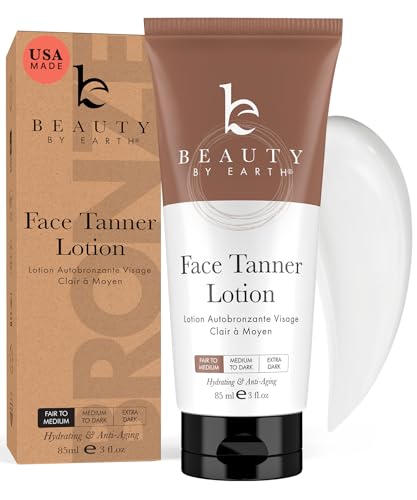
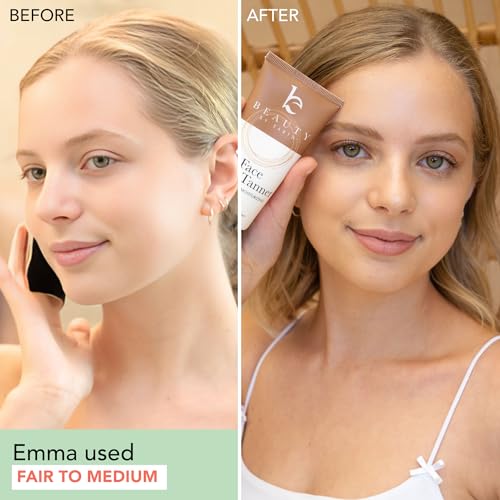
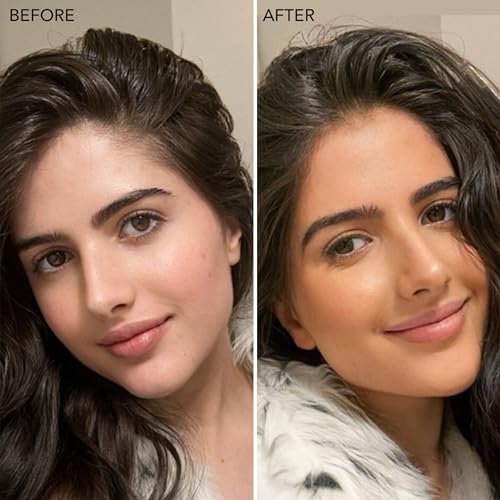
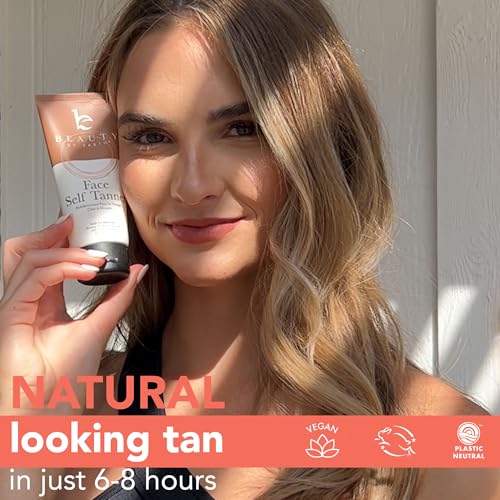
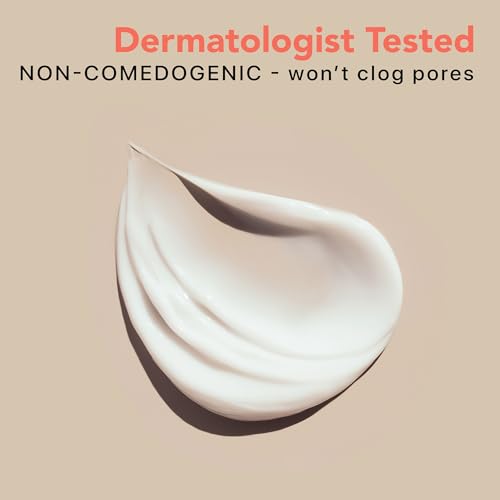
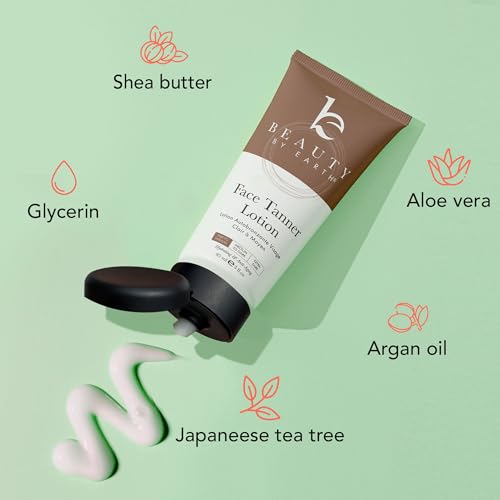
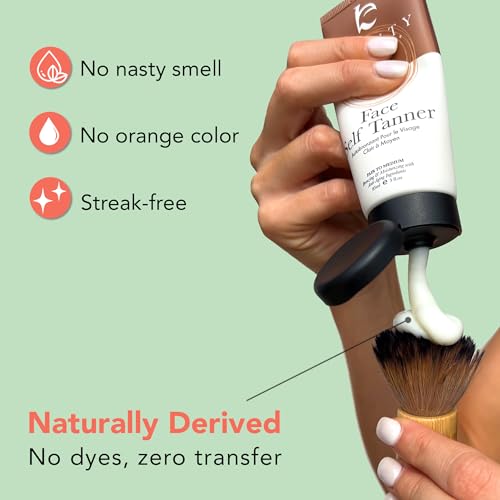
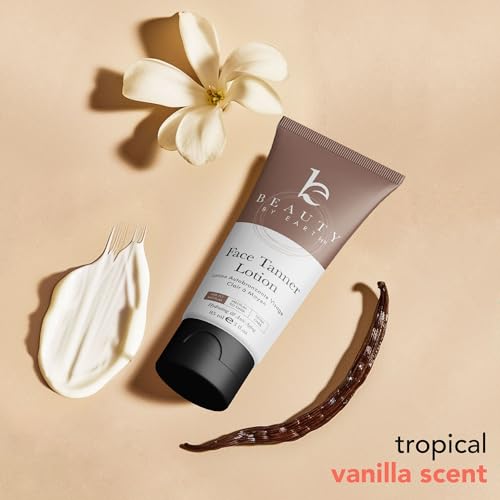
Face Tanner - Natural Ingredients, Quick-Drying, Vegan Formula - Gradual Tanning Lotion


Dihydroxyacetone
High RiskDihydroxyacetone is an aliphatic ketone commonly used as a color additive in cosmetics, particularly in self-tanning products. It reacts with amino acids in the skin to produce a temporary brown color, mimicking a tan without exposure to UV radiation.
Sustai Insights
Dihydroxyacetone offers functional benefits as a skin-tanning agent without UV exposure, making it a safer alternative for achieving a bronzed appearance. However, it carries high use restrictions and is associated with low health risks such as irritation. Environmental concerns include its potential to contribute to pollution, while regulatory bodies may issue warnings regarding its use. Overall, the ingredient presents a high risk, necessitating careful consideration of usage practices and potential alternatives.
Glycerin
Medium RiskGlycerin (also called glycerol) is a naturally occurring compound commonly used in personal care and cosmetic products. It functions as a humectant, attracting moisture to the skin, and is also utilized as a solvent and emollient to enhance product texture and stability.
Sustai Insights
Glycerin is valued for its effective moisturizing properties and biodegradability, making it a widely accepted ingredient in formulations. It poses low health risks, including low concerns for carcinogenicity and allergies. However, moderate use restrictions exist due to regulatory guidelines. While glycerin does not significantly contribute to environmental pollution, its production process should be ethically sourced. Overall, glycerin holds a medium risk level, emphasizing the importance of safe usage practices and considering sustainable alternatives.
Citric Acid
Medium RiskCitric acid is an alpha hydroxy acid used in personal care products primarily for its role as a pH adjuster and natural preservative. It occurs naturally in citrus fruits and is commonly utilized in various formulations for its chelating properties and mild exfoliation benefits.
Sustai Insights
Citric acid offers functional benefits as an effective preservative and pH stabilizer, contributing to product longevity and stability. It is biodegradable and derived from renewable sources. Health risks are low, with minimal concerns regarding carcinogenicity, allergies, and reproductive toxicity. However, moderate use restrictions exist due to potential irritation at high concentrations. Environmental risks are limited, as citric acid is not known to accumulate in ecosystems. Regulatory agencies have no significant advisories against its use. Overall, it is assessed as a medium-risk ingredient, with safe usage practices recommended and alternatives available.
Vanilla Tahitensis Fruit Extract
Low RiskVanilla tahitensis fruit extract is an extract derived from the fruit of the Tahitian vanilla plant, primarily used for its aromatic properties in cosmetic formulations. It serves as a fragrance component and may also provide some antioxidant benefits in skin care products.
Sustai Insights
Vanilla tahitensis fruit extract offers functional benefits as a natural fragrance agent and may have mild antioxidant properties. The ingredient is associated with low health risks, including negligible potential for cancer, allergies, or reproductive toxicity. Environmentally, it poses low risks and is not known to be bioaccumulative. Regulatory assessments indicate no significant concerns. Overall, the ingredient is considered low risk, with safe usage practices likely leading to positive consumer experiences.
Argania Spinosa (Argan) Kernel Oil
Low RiskArgania spinosa (argan) kernel oil is a fixed oil extracted from the kernels of the argan tree, native to Morocco. It is commonly used in cosmetic formulations for its moisturizing properties, serving as an emollient and skin conditioner.
Sustai Insights
Argania spinosa kernel oil offers functional benefits such as effective hydration and nourishment for the skin and hair. It is sustainably sourced and biodegradable, contributing positively to environmental considerations. Health risks are low, with minimal concerns regarding carcinogenicity, allergies, or reproductive toxicity. There are no current regulatory restrictions on its use. Overall, it poses low risk, making it a suitable ingredient in cosmetic products. Safe usage practices should be maintained, and alternatives like jojoba oil may also be considered for similar benefits.
Vaccinium Macrocarpon (Cranberry) Fruit Extract
Low RiskVaccinium macrocarpon (cranberry) fruit extract is derived from the fruit of the cranberry plant. It is commonly used in cosmetic and personal care products for its antioxidant properties and ability to provide moisture and nourishment to the skin.
Sustai Insights
Cranberry fruit extract offers functional benefits such as antioxidant protection and skin hydration, contributing positively to product efficacy. It is sustainably sourced and generally recognized as safe, presenting low health risks, including minimal concerns for carcinogenicity and irritation. Environmental impacts are low, with no significant pollutant or bioaccumulation concerns. Regulatory assessments indicate no restrictions. Overall, cranberry fruit extract is considered low risk, and safe usage practices involve normal cosmetic applications. Alternatives include other fruit extracts with similar benefits.
Punica Granatum (Pomegranate) Extract
Low RiskPunica granatum (pomegranate) extract is derived from the fruit of the pomegranate. It is commonly used in cosmetic formulations for its antioxidant properties and is believed to support skin health.
Sustai Insights
Pomegranate extract offers functional benefits such as antioxidant protection and skin conditioning. It is considered low risk regarding health concerns, with minimal potential for carcinogenicity, allergies, and reproductive toxicity. Environmental impact appears low, with no significant pollutant or bioaccumulation potential. Regulatory bodies do not impose restrictions on its use. Safe usage practices should be followed, though no significant alternatives are noted. Overall, the ingredient is assessed as low risk.
Camellia Oleifera (Tea Oil Camellia) Leaf Extract
Low RiskCamellia oleifera (tea oil camellia) leaf extract is an extract obtained from the leaves of the Camellia oleifera plant, primarily utilized for its functional properties in cosmetic and personal care products. It is valued for its potential moisturizing and soothing attributes.
Sustai Insights
Camellia oleifera leaf extract offers beneficial functional properties, such as moisturizing and soothing effects on the skin. It is sustainably sourced and generally recognized as safe, with low health risks related to carcinogenicity, allergies, and reproductive toxicity. Environmental concerns are minimal, as the ingredient does not bioaccumulate or contribute significantly to pollution. Regulatory assessments show no current restrictions, confirming its safety for use. Overall, the ingredient is considered low risk, with no major adverse effects reported, making it a suitable choice in formulations.
Sorbitan Olivate
Low RiskSorbitan olivate is a surfactant derived from olive oil and sorbitol. It functions primarily as an emulsifier, allowing for the mixing of oil and water in cosmetic formulations. It is commonly found in creams and lotions, enhancing texture and stability.
Sustai Insights
Sorbitan olivate offers functional benefits as an emulsifier, improving product texture and stability while being derived from a sustainable source. Health risks are low, with no significant concerns regarding carcinogenicity, allergies, or reproductive toxicity. Environmentally, it is not known to bioaccumulate or contribute to pollution. Regulatory bodies have not identified restrictions, indicating a favorable risk level. For safe usage, it is recommended in standard cosmetic formulations, with few alternatives necessary given its low-risk profile.
Magnesium Stearate
Low RiskMagnesium stearate is a magnesium salt of stearic acid, commonly used as a lubricant and anti-caking agent in pharmaceuticals and cosmetic products. It helps in the manufacturing process by preventing ingredients from clumping together and ensuring even distribution in formulations.
Sustai Insights
Magnesium stearate is recognized for its functional benefits as a lubricant and anti-caking agent, enhancing product stability. It is considered low risk regarding health concerns, including carcinogenicity and allergenic potential, with no significant environmental hazards reported. Regulatory bodies, including the FDA, have not imposed major restrictions, supporting its safe use in various applications. Recommended usage levels are typically low, maintaining safety in formulations. Overall, the ingredient is assessed as low risk, with no significant adverse health or environmental impacts identified.
Hamamelis Virginiana (Witch Hazel) Extract
Low RiskHamamelis virginiana (witch hazel) extract is derived from the bark and leaves of the witch hazel plant. It is commonly used in cosmetic products for its astringent properties, helping to tighten skin and reduce irritation. The extract is recognized for its soothing effects on the skin.
Sustai Insights
Witch hazel extract provides functional benefits as an astringent, helping to minimize skin irritation and enhance skin appearance. It is generally considered low risk for health concerns, with minimal evidence of carcinogenicity, allergenic potential, or reproductive toxicity. Environmental impact is also low, as it does not significantly contribute to pollution or bioaccumulation. Regulatory bodies have not issued major warnings, supporting its safety for use in cosmetics. For safe usage, it is recommended to avoid contact with eyes and to use in appropriate concentrations. Overall, it is regarded as a low-risk ingredient.
Isostearyl Isostearate
Low RiskIsostearyl isostearate is an ester derived from isostearic acid and isostearate alcohol. It functions primarily as an emollient and skin-conditioning agent in cosmetic formulations, enhancing texture and moisture retention in products like creams and lotions.
Sustai Insights
Isostearyl isostearate offers functional benefits as an effective emollient, contributing to the smooth application and moisturizing properties of products. It is considered low risk for health concerns such as carcinogenicity, allergies, and reproductive toxicity. Environmental assessments indicate minimal pollution potential, with no significant bioaccumulation. Currently, there are no strict regulatory warnings against its use. Overall, its risk level is assessed as low, making it a safe ingredient in cosmetics. Alternatives could include other plant-based esters for those seeking more sustainable options.
Cetearyl Olivate
Low RiskCetearyl olivate is composed of cetearyl alcohol and the fatty acids derived from olive oil. It is primarily used as an emulsifier and skin-conditioning agent in cosmetic formulations, helping to stabilize and enhance the texture of creams and lotions.
Sustai Insights
Cetearyl olivate serves as an effective emulsifier, contributing to product stability and texture. It is derived from olive oil, making it a sustainable choice due to its biodegradable nature. Health concerns are low, with minimal risks for irritation and allergies. Regulatory status is favorable, with no significant warnings. Environmental risks are also low, indicating it does not pose substantial hazards. Overall, the ingredient presents a low risk profile, making it a safe option in cosmetic products.
Dicaprylyl Carbonate
Low RiskDicaprylyl carbonate is a diester of carbonic acid, commonly used in cosmetic formulations as an emollient and skin-conditioning agent. It enhances the texture and feel of products, providing a light, non-greasy finish while helping to dissolve and stabilize other ingredients.
Sustai Insights
Dicaprylyl carbonate offers effective emollient properties, improving product aesthetics and skin feel. It presents a low risk for health concerns like carcinogenicity, allergies, or irritation. Environmentally, it shows low bioaccumulation potential and is not a significant pollutant. Regulatory bodies do not impose notable restrictions on its use. Overall, it is considered low risk, making it a safe choice for cosmetic applications.
Leuconostoc/Radish Root Ferment Filtrate
Low RiskLeuconostoc/radish root ferment filtrate is a natural fermentation product derived from radish roots, commonly used in skincare for its potential preservative properties and skin-conditioning benefits. It functions by harnessing the metabolic activity of Leuconostoc bacteria to provide a source of beneficial compounds.
Sustai Insights
This ingredient offers functional benefits, primarily as a preservative and skin-conditioning agent, while being biodegradable and sustainably sourced. Health risks are generally low, with no significant concerns regarding carcinogenicity or allergies, though contamination concerns exist. Environmentally, it poses minimal risks, categorized as low overall risk based on current scientific consensus. Safe usage practices are advised, and alternatives may include other natural preservatives like tocopherol or rosemary extract.
Water
Low RiskWater is a clear, colorless liquid essential for various biological processes. It serves as a solvent in formulations, facilitating the dissolution of other ingredients and enhancing product texture and application. Additionally, water plays a crucial role in hydration and is a key component in many cosmetic and personal care products.
Sustai Insights
Water is an effective solvent and hydrator, contributing to the texture and efficacy of formulations. It is biodegradable and generally regarded as safe, with low concerns regarding carcinogenicity, allergies, and reproductive toxicity. However, excessive water usage can lead to environmental concerns, particularly regarding resource depletion. Regulatory bodies do not impose restrictions on water use in cosmetics. Overall, the risks associated with water are low, making it a safe and essential ingredient.
Butyrospermum Parkii (Shea) Butter
Low RiskButyrospermum parkii (shea) butter is a vegetable fat derived from the nuts of the shea tree. It is commonly used in cosmetic formulations for its emollient properties, providing moisture and improving skin texture. Additionally, shea butter is known for its ability to enhance the stability of products and deliver a creamy texture.
Sustai Insights
Shea butter offers functional benefits as an effective moisturizer, enhancing skin barrier function and texture. It is sustainably sourced and biodegradable, contributing to eco-friendliness. Health-wise, it is associated with low risks for carcinogenicity, allergies, and reproductive toxicity. Environmental impacts are minimal, with no significant pollutant potential identified. Regulatory assessments indicate no current restrictions. Overall, the ingredient presents a low risk, making it a favorable choice in cosmetic formulations.
Simmondsia Chinensis (Jojoba) Seed Oil
Low RiskSimmondsia chinensis (jojoba) seed oil is extracted from the seeds of the jojoba plant. It is commonly used in cosmetics for its moisturizing properties and ability to mimic human sebum, making it beneficial for skin and hair care formulations.
Sustai Insights
Jojoba seed oil offers functional benefits such as effective moisturization and emollience, contributing to skin hydration and smoothness. It is sustainably sourced and biodegradable. Health risks are low, with minimal concerns regarding carcinogenicity, allergies, and reproductive toxicity. Environmental risks are also low, as it does not significantly contribute to pollution or bioaccumulation. Currently, there are no regulatory restrictions on its use. Overall, the risk level is low, and it is considered a safe ingredient with no significant adverse effects.
Aloe Barbadensis (Aloe Vera) Leaf Juice
Low RiskAloe barbadensis (aloe vera) leaf juice is derived from the succulent aloe vera plant, known for its hydrating and soothing properties. It is commonly used in cosmetic formulations for its moisturizing effects and is often included in products aimed at skin care and healing.
Sustai Insights
Aloe vera leaf juice offers functional benefits as a moisturizer and skin soothing agent, while being sustainably sourced and biodegradable. Health risks are low, with minimal concerns regarding carcinogenicity, allergies, and reproductive toxicity. Environmental impact is also low, with no significant pollutants identified. Regulatory agencies impose few restrictions. Overall, the ingredient poses a low risk, making it a favorable choice in cosmetic formulations.
Vanilla Tahitensis Fruit Extract
Low RiskVanilla tahitensis fruit extract is an extract derived from the fruit of the Tahitian vanilla plant, primarily used for its aromatic properties in cosmetic formulations. It serves as a fragrance component and may also provide some antioxidant benefits in skin care products.
Sustai Insights
Vanilla tahitensis fruit extract offers functional benefits as a natural fragrance agent and may have mild antioxidant properties. The ingredient is associated with low health risks, including negligible potential for cancer, allergies, or reproductive toxicity. Environmentally, it poses low risks and is not known to be bioaccumulative. Regulatory assessments indicate no significant concerns. Overall, the ingredient is considered low risk, with safe usage practices likely leading to positive consumer experiences.
Argania Spinosa (Argan) Kernel Oil
Low RiskArgania spinosa (argan) kernel oil is a fixed oil extracted from the kernels of the argan tree, native to Morocco. It is commonly used in cosmetic formulations for its moisturizing properties, serving as an emollient and skin conditioner.
Sustai Insights
Argania spinosa kernel oil offers functional benefits such as effective hydration and nourishment for the skin and hair. It is sustainably sourced and biodegradable, contributing positively to environmental considerations. Health risks are low, with minimal concerns regarding carcinogenicity, allergies, or reproductive toxicity. There are no current regulatory restrictions on its use. Overall, it poses low risk, making it a suitable ingredient in cosmetic products. Safe usage practices should be maintained, and alternatives like jojoba oil may also be considered for similar benefits.
Vaccinium Macrocarpon (Cranberry) Fruit Extract
Low RiskVaccinium macrocarpon (cranberry) fruit extract is derived from the fruit of the cranberry plant. It is commonly used in cosmetic and personal care products for its antioxidant properties and ability to provide moisture and nourishment to the skin.
Sustai Insights
Cranberry fruit extract offers functional benefits such as antioxidant protection and skin hydration, contributing positively to product efficacy. It is sustainably sourced and generally recognized as safe, presenting low health risks, including minimal concerns for carcinogenicity and irritation. Environmental impacts are low, with no significant pollutant or bioaccumulation concerns. Regulatory assessments indicate no restrictions. Overall, cranberry fruit extract is considered low risk, and safe usage practices involve normal cosmetic applications. Alternatives include other fruit extracts with similar benefits.
Punica Granatum (Pomegranate) Extract
Low RiskPunica granatum (pomegranate) extract is derived from the fruit of the pomegranate. It is commonly used in cosmetic formulations for its antioxidant properties and is believed to support skin health.
Sustai Insights
Pomegranate extract offers functional benefits such as antioxidant protection and skin conditioning. It is considered low risk regarding health concerns, with minimal potential for carcinogenicity, allergies, and reproductive toxicity. Environmental impact appears low, with no significant pollutant or bioaccumulation potential. Regulatory bodies do not impose restrictions on its use. Safe usage practices should be followed, though no significant alternatives are noted. Overall, the ingredient is assessed as low risk.
Camellia Oleifera (Tea Oil Camellia) Leaf Extract
Low RiskCamellia oleifera (tea oil camellia) leaf extract is an extract obtained from the leaves of the Camellia oleifera plant, primarily utilized for its functional properties in cosmetic and personal care products. It is valued for its potential moisturizing and soothing attributes.
Sustai Insights
Camellia oleifera leaf extract offers beneficial functional properties, such as moisturizing and soothing effects on the skin. It is sustainably sourced and generally recognized as safe, with low health risks related to carcinogenicity, allergies, and reproductive toxicity. Environmental concerns are minimal, as the ingredient does not bioaccumulate or contribute significantly to pollution. Regulatory assessments show no current restrictions, confirming its safety for use. Overall, the ingredient is considered low risk, with no major adverse effects reported, making it a suitable choice in formulations.
Sorbitan Olivate
Low RiskSorbitan olivate is a surfactant derived from olive oil and sorbitol. It functions primarily as an emulsifier, allowing for the mixing of oil and water in cosmetic formulations. It is commonly found in creams and lotions, enhancing texture and stability.
Sustai Insights
Sorbitan olivate offers functional benefits as an emulsifier, improving product texture and stability while being derived from a sustainable source. Health risks are low, with no significant concerns regarding carcinogenicity, allergies, or reproductive toxicity. Environmentally, it is not known to bioaccumulate or contribute to pollution. Regulatory bodies have not identified restrictions, indicating a favorable risk level. For safe usage, it is recommended in standard cosmetic formulations, with few alternatives necessary given its low-risk profile.
Dihydroxyacetone
High RiskDihydroxyacetone is an aliphatic ketone commonly used as a color additive in cosmetics, particularly in self-tanning products. It reacts with amino acids in the skin to produce a temporary brown color, mimicking a tan without exposure to UV radiation.
Sustai Insights
Dihydroxyacetone offers functional benefits as a skin-tanning agent without UV exposure, making it a safer alternative for achieving a bronzed appearance. However, it carries high use restrictions and is associated with low health risks such as irritation. Environmental concerns include its potential to contribute to pollution, while regulatory bodies may issue warnings regarding its use. Overall, the ingredient presents a high risk, necessitating careful consideration of usage practices and potential alternatives.
Magnesium Stearate
Low RiskMagnesium stearate is a magnesium salt of stearic acid, commonly used as a lubricant and anti-caking agent in pharmaceuticals and cosmetic products. It helps in the manufacturing process by preventing ingredients from clumping together and ensuring even distribution in formulations.
Sustai Insights
Magnesium stearate is recognized for its functional benefits as a lubricant and anti-caking agent, enhancing product stability. It is considered low risk regarding health concerns, including carcinogenicity and allergenic potential, with no significant environmental hazards reported. Regulatory bodies, including the FDA, have not imposed major restrictions, supporting its safe use in various applications. Recommended usage levels are typically low, maintaining safety in formulations. Overall, the ingredient is assessed as low risk, with no significant adverse health or environmental impacts identified.
Hamamelis Virginiana (Witch Hazel) Extract
Low RiskHamamelis virginiana (witch hazel) extract is derived from the bark and leaves of the witch hazel plant. It is commonly used in cosmetic products for its astringent properties, helping to tighten skin and reduce irritation. The extract is recognized for its soothing effects on the skin.
Sustai Insights
Witch hazel extract provides functional benefits as an astringent, helping to minimize skin irritation and enhance skin appearance. It is generally considered low risk for health concerns, with minimal evidence of carcinogenicity, allergenic potential, or reproductive toxicity. Environmental impact is also low, as it does not significantly contribute to pollution or bioaccumulation. Regulatory bodies have not issued major warnings, supporting its safety for use in cosmetics. For safe usage, it is recommended to avoid contact with eyes and to use in appropriate concentrations. Overall, it is regarded as a low-risk ingredient.
Isostearyl Isostearate
Low RiskIsostearyl isostearate is an ester derived from isostearic acid and isostearate alcohol. It functions primarily as an emollient and skin-conditioning agent in cosmetic formulations, enhancing texture and moisture retention in products like creams and lotions.
Sustai Insights
Isostearyl isostearate offers functional benefits as an effective emollient, contributing to the smooth application and moisturizing properties of products. It is considered low risk for health concerns such as carcinogenicity, allergies, and reproductive toxicity. Environmental assessments indicate minimal pollution potential, with no significant bioaccumulation. Currently, there are no strict regulatory warnings against its use. Overall, its risk level is assessed as low, making it a safe ingredient in cosmetics. Alternatives could include other plant-based esters for those seeking more sustainable options.
Cetearyl Olivate
Low RiskCetearyl olivate is composed of cetearyl alcohol and the fatty acids derived from olive oil. It is primarily used as an emulsifier and skin-conditioning agent in cosmetic formulations, helping to stabilize and enhance the texture of creams and lotions.
Sustai Insights
Cetearyl olivate serves as an effective emulsifier, contributing to product stability and texture. It is derived from olive oil, making it a sustainable choice due to its biodegradable nature. Health concerns are low, with minimal risks for irritation and allergies. Regulatory status is favorable, with no significant warnings. Environmental risks are also low, indicating it does not pose substantial hazards. Overall, the ingredient presents a low risk profile, making it a safe option in cosmetic products.
Dicaprylyl Carbonate
Low RiskDicaprylyl carbonate is a diester of carbonic acid, commonly used in cosmetic formulations as an emollient and skin-conditioning agent. It enhances the texture and feel of products, providing a light, non-greasy finish while helping to dissolve and stabilize other ingredients.
Sustai Insights
Dicaprylyl carbonate offers effective emollient properties, improving product aesthetics and skin feel. It presents a low risk for health concerns like carcinogenicity, allergies, or irritation. Environmentally, it shows low bioaccumulation potential and is not a significant pollutant. Regulatory bodies do not impose notable restrictions on its use. Overall, it is considered low risk, making it a safe choice for cosmetic applications.
Leuconostoc/Radish Root Ferment Filtrate
Low RiskLeuconostoc/radish root ferment filtrate is a natural fermentation product derived from radish roots, commonly used in skincare for its potential preservative properties and skin-conditioning benefits. It functions by harnessing the metabolic activity of Leuconostoc bacteria to provide a source of beneficial compounds.
Sustai Insights
This ingredient offers functional benefits, primarily as a preservative and skin-conditioning agent, while being biodegradable and sustainably sourced. Health risks are generally low, with no significant concerns regarding carcinogenicity or allergies, though contamination concerns exist. Environmentally, it poses minimal risks, categorized as low overall risk based on current scientific consensus. Safe usage practices are advised, and alternatives may include other natural preservatives like tocopherol or rosemary extract.
Water
Low RiskWater is a clear, colorless liquid essential for various biological processes. It serves as a solvent in formulations, facilitating the dissolution of other ingredients and enhancing product texture and application. Additionally, water plays a crucial role in hydration and is a key component in many cosmetic and personal care products.
Sustai Insights
Water is an effective solvent and hydrator, contributing to the texture and efficacy of formulations. It is biodegradable and generally regarded as safe, with low concerns regarding carcinogenicity, allergies, and reproductive toxicity. However, excessive water usage can lead to environmental concerns, particularly regarding resource depletion. Regulatory bodies do not impose restrictions on water use in cosmetics. Overall, the risks associated with water are low, making it a safe and essential ingredient.
Glycerin
Medium RiskGlycerin (also called glycerol) is a naturally occurring compound commonly used in personal care and cosmetic products. It functions as a humectant, attracting moisture to the skin, and is also utilized as a solvent and emollient to enhance product texture and stability.
Sustai Insights
Glycerin is valued for its effective moisturizing properties and biodegradability, making it a widely accepted ingredient in formulations. It poses low health risks, including low concerns for carcinogenicity and allergies. However, moderate use restrictions exist due to regulatory guidelines. While glycerin does not significantly contribute to environmental pollution, its production process should be ethically sourced. Overall, glycerin holds a medium risk level, emphasizing the importance of safe usage practices and considering sustainable alternatives.
Citric Acid
Medium RiskCitric acid is an alpha hydroxy acid used in personal care products primarily for its role as a pH adjuster and natural preservative. It occurs naturally in citrus fruits and is commonly utilized in various formulations for its chelating properties and mild exfoliation benefits.
Sustai Insights
Citric acid offers functional benefits as an effective preservative and pH stabilizer, contributing to product longevity and stability. It is biodegradable and derived from renewable sources. Health risks are low, with minimal concerns regarding carcinogenicity, allergies, and reproductive toxicity. However, moderate use restrictions exist due to potential irritation at high concentrations. Environmental risks are limited, as citric acid is not known to accumulate in ecosystems. Regulatory agencies have no significant advisories against its use. Overall, it is assessed as a medium-risk ingredient, with safe usage practices recommended and alternatives available.
Butyrospermum Parkii (Shea) Butter
Low RiskButyrospermum parkii (shea) butter is a vegetable fat derived from the nuts of the shea tree. It is commonly used in cosmetic formulations for its emollient properties, providing moisture and improving skin texture. Additionally, shea butter is known for its ability to enhance the stability of products and deliver a creamy texture.
Sustai Insights
Shea butter offers functional benefits as an effective moisturizer, enhancing skin barrier function and texture. It is sustainably sourced and biodegradable, contributing to eco-friendliness. Health-wise, it is associated with low risks for carcinogenicity, allergies, and reproductive toxicity. Environmental impacts are minimal, with no significant pollutant potential identified. Regulatory assessments indicate no current restrictions. Overall, the ingredient presents a low risk, making it a favorable choice in cosmetic formulations.
Simmondsia Chinensis (Jojoba) Seed Oil
Low RiskSimmondsia chinensis (jojoba) seed oil is extracted from the seeds of the jojoba plant. It is commonly used in cosmetics for its moisturizing properties and ability to mimic human sebum, making it beneficial for skin and hair care formulations.
Sustai Insights
Jojoba seed oil offers functional benefits such as effective moisturization and emollience, contributing to skin hydration and smoothness. It is sustainably sourced and biodegradable. Health risks are low, with minimal concerns regarding carcinogenicity, allergies, and reproductive toxicity. Environmental risks are also low, as it does not significantly contribute to pollution or bioaccumulation. Currently, there are no regulatory restrictions on its use. Overall, the risk level is low, and it is considered a safe ingredient with no significant adverse effects.
Aloe Barbadensis (Aloe Vera) Leaf Juice
Low RiskAloe barbadensis (aloe vera) leaf juice is derived from the succulent aloe vera plant, known for its hydrating and soothing properties. It is commonly used in cosmetic formulations for its moisturizing effects and is often included in products aimed at skin care and healing.
Sustai Insights
Aloe vera leaf juice offers functional benefits as a moisturizer and skin soothing agent, while being sustainably sourced and biodegradable. Health risks are low, with minimal concerns regarding carcinogenicity, allergies, and reproductive toxicity. Environmental impact is also low, with no significant pollutants identified. Regulatory agencies impose few restrictions. Overall, the ingredient poses a low risk, making it a favorable choice in cosmetic formulations.
Discover a sun-kissed glow all year round with our Face Tanner, crafted in the USA from natural and organic ingredients. This non-toxic self-tanning lotion is perfect for both men and women, offering a customizable tan that enhances your natural beauty without harmful chemicals.
- Customizable Shades: Choose from fair to medium or medium to dark, ensuring a personalized, natural look without the orange hue.
- Fast-Acting Formula: Achieve a radiant bronze in just a few hours with our quick-drying formula, ideal for busy lifestyles.
- Clean & Cruelty-Free: Enjoy peace of mind with our vegan, toxin-free formula, proudly made in the USA, emphasizing ethical practices.
- Easy Application: Designed for even coverage, this lotion pairs perfectly with exfoliating gloves for a smooth finish.
- Satisfaction Guaranteed: We stand by our product; if you're not satisfied, our customer service team is ready to assist you.
Subscribe & Save with Sustai
- Best Price Guarantee: Always enjoy the lowest prices on sustainable home essentials.
- No Surprises: We’ll notify you before shipping. No hidden fees, ever.
- You’re in Charge: Change, pause, or cancel your subscription anytime with ease.
- Eco-Friendly Deliveries: Our grouped shipments mean less packaging and lower emissions.
Join us on a sustainable journey. Special offers for a limited time! Prices and promotions may change.
Recommended Products
Discover a sun-kissed glow all year round with our Face Tanner, crafted in the USA from natural and organic ingredients. This non-toxic self-tanning lotion is perfect for both men and women, offering a customizable tan that enhances your natural beauty without harmful chemicals.
- Customizable Shades: Choose from fair to medium or medium to dark, ensuring a personalized, natural look without the orange hue.
- Fast-Acting Formula: Achieve a radiant bronze in just a few hours with our quick-drying formula, ideal for busy lifestyles.
- Clean & Cruelty-Free: Enjoy peace of mind with our vegan, toxin-free formula, proudly made in the USA, emphasizing ethical practices.
- Easy Application: Designed for even coverage, this lotion pairs perfectly with exfoliating gloves for a smooth finish.
- Satisfaction Guaranteed: We stand by our product; if you're not satisfied, our customer service team is ready to assist you.

You can have at most 2 Sustainable Steals products in your cart
Customer Reviews
Customers’ View
Customers appreciate the effectiveness and eco-friendly nature of this self-tanner, often highlighting its natural and organic ingredients. Many users report enjoying a customizable and natural-looking tan without the typical strong odor associated with other products. One customer noted, "This is the very best self tanner I have ever used. No strong smell. Gives a great tan glow--no fake look AT ALL!" Additionally, the quick-drying formula and streak-free application are frequently commended, making it suitable for busy lifestyles. However, some users mentioned that the tan may not last as long as expected, indicating a need for regular reapplication. Overall, customers find this product effective and aligned with their sustainable lifestyle choices.
AI-generated from the text of customer reviewsThis product is rated 4.5 of 5.0 stars.
It has received 6 reviews.





